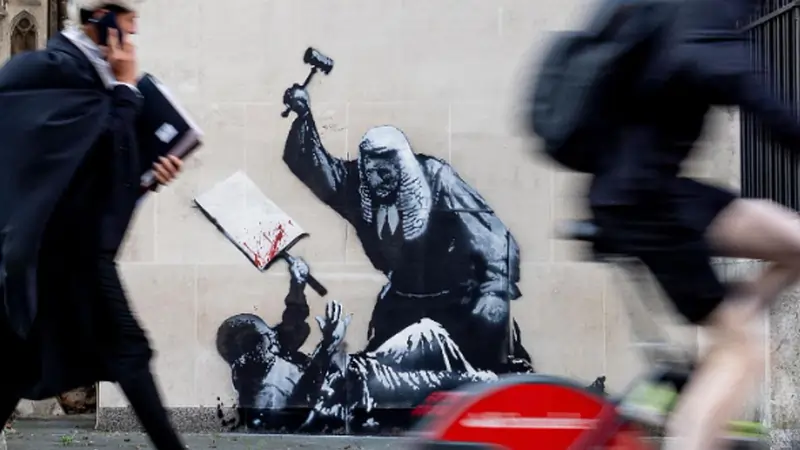Banksy’s latest controversial artwork depicts a judge attacking a protester with a gavel on the wall of London’s Royal Courts of Justice, created as a powerful statement against the government’s crackdown on pro-Palestinian demonstrators and the criminalization of peaceful protest.
What Does Banksy’s Latest Artwork Depict?
The new Banksy artwork, which appeared on the Queen’s Building at the Royal Courts of Justice complex in London, shows a dramatic scene where:
- A judge in traditional wig and gown looms over a protester lying on the ground
- The judge is wielding a gavel as if attacking the protester
- The protester is holding a blood-spattered placard
- The entire scene is rendered in Banksy’s signature stenciled graffiti style
This powerful imagery was quickly covered up by authorities using large sheets of black plastic and metal barriers, though not before Banksy himself shared a photo of the work on Instagram with the simple caption: “Royal Courts Of Justice. London.”
Why Did Banksy Create This Controversial Artwork?
Banksy created this artwork as a direct response to recent political events in the UK, specifically:
- The arrest of hundreds of demonstrators supporting the banned group Palestine Action during weekend protests
- The government’s decision to proscribe Palestine Action, making it a criminal offense to support the organization
- What critics describe as the use of law as “a tool to crush civil liberties”
A spokesperson for the campaign group Defend Our Juries, which organized Saturday’s rally, stated that Banksy’s work “powerfully depicts the brutality unleashed by Yvette Cooper on protesters by proscribing Palestine Action.” They added that “when the law is used as a tool to crush civil liberties, it does not extinguish dissent, it strengthens it.”
The Political Context Behind the Artwork
The timing and location of Banksy’s artwork are highly significant:
- The Royal Courts of Justice represents the heart of the British legal system
- The artwork appeared following mass arrests of pro-Palestinian protesters
- It directly critiques the government’s approach to protest and civil liberties
- The piece continues Banksy’s long tradition of political commentary through street art
Banksy’s History of Political Art
This latest piece follows Banksy’s established pattern of creating art that comments on political issues. His stenciled graffiti frequently criticizes:
- Government policies and decisions
- War and military action
- Capitalism and corporate power
- Social injustice and inequality
Just last summer, Banksy made headlines with his animal-themed collection across London, which included works like piranhas on a police sentry box and a gorilla lifting a shutter at London Zoo. However, this latest work returns to more overt political commentary, similar to his earlier pieces that directly address current events and government actions.
Why This Artwork Matters
Banksy’s judge and protester artwork matters because it:
- Highlights the tension between state power and citizen protest
- Brings international attention to UK protest laws and their enforcement
- Demonstrates art’s power to comment on contemporary political issues
- Continues the tradition of street art as a form of social and political dissent
The artwork’s rapid covering by authorities only serves to underscore its message about the suppression of dissent, making Banksy’s statement even more powerful in the eyes of viewers worldwide.



